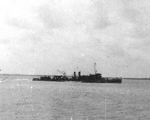
| 122k | Born on 25 November 1805 at Smithfield, Va., William Ballard Preston entered Hampton-Sydney College in 1821, where he
was active in literary and forensic activities. Graduating in 1824, Preston studied law at the University of Virginia and was admitted to the bar in 1826. The young
attorney soon entered politics as a Whig and was elected to the Virginia House of Delegates in 1830. During the 1831-1832 session, he took an active part in the
campaign to abolish slavery. Then there followed an eight-year hiatus in his political activities during which he returned to the practice of law. In 1840, he was
elected to the State Senate, where he served from 1840 to 1844, before returning to the House of Delegates. In 1846, he was elected to the United States House of
Representatives. In March of 1849, President Zachary Taylor appointed the Virginia lawyer and congressman Secretary of the Navy. During Preston's tenure in that office,
the United States Navy acquired new duties in the course of America's westward expansion and acquisition of California. Trade and commerce in the Pacific beckoned, and
the Stars and Stripes flew from the masts of Navy ships in Chinese waters, while the shores of Japan, then unopened to the west, presented a tantalizing possibility for
commercial intercourse. The Navy also was progressing through a technological transition, especially in the area of moving from sails to steam propulsion, and with the
improvements in gunnery and naval ordnance. Upon the death of President Taylor, new President Millard Fillmore reorganized the cabinet and appointed another Secretary
of the Navy. Preston retired from office and withdrew from politics and public life. Resuming his private law practice, Preston acquired a reputation for being a fine
defense lawyer before being sent to France in 1858 to negotiate for the establishment of a line of commercial steamers to operate between Le Havre and Norfolk. The
mission to France progressed well, and the project appeared promising until it was brought to naught by the American Civil War. As states in the lower South seceded
from the Union, the pressure mounted upon Virginia to do likewise. Moderate sentiment still held sway through 1860; but, early in 1861, increasing tensions forced
Virginians to consider secession. On 13 February 1861, the secession convention met in Richmond and numbered William B. Preston amongst the delegates. As the
Confederacy was established and the United States divided into two hostile camps, both sides moved steadily toward open conflict. A special delegation, composed of
William B. Preston, H. H. Stuart, and George W. Randolph, traveled to Washington where they met President Lincoln on 12 April. Finding the President firm in his resolve
to hold the Federal forts then in the South, the three men returned to Richmond on the 15th. With the news of the firing on Fort Sumter in South Carolina on 12 April
1861, conservative and moderate strength in the secessionist convention melted away. On the 16th, convinced that secession was inevitable, William B. Preston
submitted, in secret session, an ordinance of secession. Supported 88 to 55, the Preston Resolution passed, and Virginia left the Union. Elected senator from Virginia
in the Confederate States Congress, he served in that legislative body until his death at Smithfield on 16 November 1862.
Digital ID: cph 3c10164, Library of Congress Prints and Photographs Division Washington, D.C. | Bill Gonyo |
 |
122k |
USS William B. Preston (AVD-7) under way during the Japanese carrier air raid on Darwin, Australia, 19 February 1942. Despite
one hit and several near misses by enemy bombs, she was able to reach the open sea and escaped. Image cropped from Photo # NH 43658.
US Naval History and Heritage
Command photo # NH 43658A cropped from NH 43658 courtesy of Arthur W. Thomas. |
US Naval History and Heritage Command |



